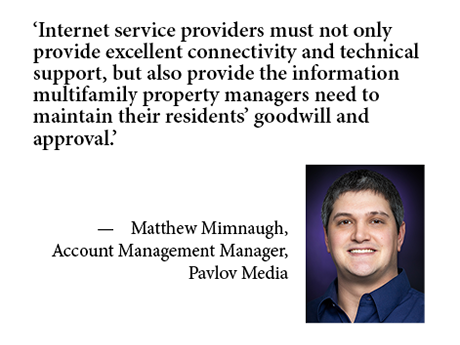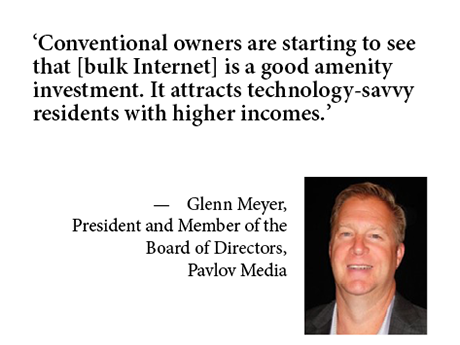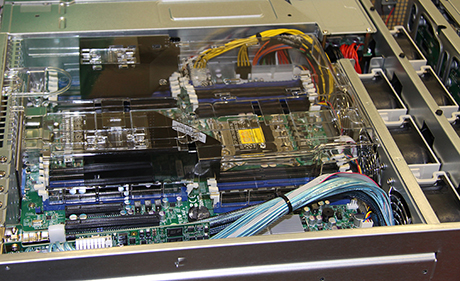By Matthew Mimnaugh, account management manager, Pavlov Media Account management, or the work to ensure repeat business and expand each client relationship, requires more than simply satisfying customers. For Internet service providers (ISPs) to the multifamily industry this means helping property managers succeed by maximizing their residents’ connectivity. Excellent Internet service leads to positive property reviews and renewed leases. Property ownership and management win. Providers that serve landlords best not only respond to service requests, but also employ a deductive approach to diagnose root problems, discover unreported deficiencies and take preemptive actions that allow smooth property operations. Below is an overview of best practices for account management and a discussion of Pavlov Media’s data analysis and behavioral pattern recognition tools we’ve developed to uncover trends and issues that can threaten connectivity and, ultimately, property performance. First Responders Giving housing managers and their residents access to a technology support team is a standard practice for many ISPs. Typically, a request generates a service ticket, and a team member responds to gather basic information before walking the customer through a scripted trouble-shooting tree to either solve the problem or elevate the ticket for more advanced assistance. This approach can be highly effective …
Pavlov Media
It’s little wonder that the fiber optic business is booming. American appetites for high-speed, high-volume Internet connectivity have skyrocketed in recent years, making fiber essential to provide Internet service across commercial property types. Employment for the linemen who build out and maintain those networks will grow 6 percent between 2021 and 2031, while telecommunications equipment installation jobs in general will expand to an even greater 8 percent, according to projections from the Bureau of Labor Statistics. Factor in the ongoing exodus of skilled workers from all trades as more of the nation’s Baby Boomers enter retirement, and many broadband providers may struggle to fill job openings in the coming years. That’s one of the reasons Pavlov Media, a Champaign, Ill.-based Internet service provider, is partnering with a Texas university to put students on career paths in fiber technology. Its partner in this endeavor, Prairie View A&M University, was founded in 1876 and is the second oldest public institution of higher education in Texas and one of the earliest 1890 Land Grant Institutions. Because it is a historically black institution, the program will be helping to address a longstanding need for greater diversity, equity and inclusiveness (DEI) in the technology sector. …
Content PartnerFeaturesLeasing ActivityMidwestMultifamilyNortheastPavlov MediaSoutheastStudent HousingTexasWestern
The Evolution of Internet Setups: How Student Housing Internet Preferences Are Influencing Traditional Multifamily
Multifamily properties have witnessed a rapid expansion in Internet needs, a trend presaged by burgeoning Internet demands in student housing. Multifamily residents have increased their connection demands and are becoming increasingly sophisticated in their requirements for high-quality Internet. What can the lessons of student housing connectivity teach us about traditional multifamily trends, especially when it comes to bulk Internet? Bulk Internet approaches allow for more sophistication in multifamily properties, as demonstrated by student housing best practices. Student housing pioneered built-in networks to keep mobile devices from competing for Wi-Fi bandwidth, minimize downtime and use fiber connections to ensure speed and reliability. This style of network is becoming the gold standard for constant, heavy-duty Internet use in multi-dwelling units (MDUs). High-level connectivity is becoming an absolute necessity for multifamily properties, drawing in residents and improving their Internet-driven lifestyles. And as never-before-seen demand for bandwidth is graduating from dorm rooms to traditional apartments, well-planned multifamily Internet connections can help operators adapt gracefully. COVID’s Role in Internet Use Expansion COVID lockdowns accelerated already growing Internet requirements, which pushed Internet quality to the forefront as connectivity became increasingly important. “COVID put the spotlight on properties to make sure they had great infrastructure. The demand …
Fiber networks built with multifamily properties in mind offer network resilience while maximizing ROI for owners and operators. Well-constructed fiber networks are at the heart of meeting and exceeding residents’ growing Internet needs, especially when work-from-home culture and the constant need for online connection have made Internet slowdowns and downtime unacceptable for end users. Fiber can also strengthen connectivity across multifamily properties, shoring up the Wi-Fi services residents have come to know and on which they’ve come to depend. How does a national fiber network integrate with multifamily properties? By focusing just on the needs of the multi-dwelling unit (MDU). “Instead of building out 200-mile routes of duct and fiber, we build out ‘miracle miles’ in densely populated MDU areas. From that point, we’re able to easily grow or expand out from that area,” says Michael O’Linc, president of fiber services & campus communications at Pavlov Media. O’Linc stresses the importance of a more planned, methodical approach for MDUs. A network that serves multifamily buildings must be a network focused on backups and fail safes. The “miracle mile” method creates a main line with laterals — creating a ring shape as it expands. This approach to fiber makes networks easier to …
The landscape of multifamily Internet access is changing rapidly, driven by evolving resident expectations. No longer merely a utility, reliable Wi-Fi and Ethernet connections are essential for attracting and retaining residents, along with cutting operation costs. Expanding connectivity needs, work-from-home (WFH) culture and growing interest in smart-home applications are all driving residents’ Internet requirements. The centrality of Internet access for multifamily residents was inevitable in the long run, according to Bryan Rader, president of Multi-Dwelling Units (MDU) at Pavlov Media. COVID lockdowns accelerated an already burgeoning trend: bulk-managed Internet designed to improve connections and simplify growing demand. Bulk-managed connectivity offers a variety of solutions for on-site managers, residents and owners, as well as cost savings in unexpected areas. This approach provides building-wide Internet connections through a single provider, rather than asking residents to sign up individually with one of several Internet providers. The bulk Internet management company may also install and manage the building’s connection infrastructure. The simplicity of bulk-managed Internet (which started as bulk-managed Wi-Fi in student housing) is becoming increasingly practical for multifamily buildings. In the last four or five years, the traditional multifamily industry is starting to follow the same model that became standard in student housing …
Older Posts






